
Region
Uttarakhand | India
Duration
6 Days
Max Altitude
12300 Ft.
Trekking Km
50 KM
Grade
Moderate
Help & Support
+91 9368882322 info@trekthehimalayas.com10:00 hrs to 18:00 hrs | GMT +5:30
Monday - Saturday | Sunday Closed
14500 /Person
- May-2024
- +5% GST (goods and services tax)
- Services Kathgodam to Kathgodam | Included Transport
- Addons
-
Insurance is Mandatory.
-
Non-Indian rates are slightly higher. Trek coordinator will provide balance payment link post-booking.
- Get insurance through us or elsewhere. If not through us, email for a refund after booking.
-
Cancellation 4 or more days before the start of the trip results in a 100% cash refund.
-
Cancellation less than 4 days from the start of the trip results in no refund.
-
Transportation Kathgodam to Kathgodam & retun is optional
-
Choose add-ons during booking. If missed, log in and add them later
-
Book transportation at least 10 days before the trek.
-
Cancellation 4 or more days before the start of the trip results in a 100% cash refund.
-
Cancellation less than 4 days from the start of the trip results in a 50% cash refund.
-
Cancellation after the trip date does not qualify for a refund.
-
Backpack offload is optional
-
Choose add-ons during booking. If missed, log in and add them later.
-
Book off-load at least 10 days before the trek.
-
For offline bookings at the base camp, a convenience fee of Rs. 2100 applies.
-
Cancellations made before the trip date will receive a full refund.
Insurance 245
Transport 1400
Offload 1800
For more information. Please complete this form.
Help & Support
+91 991 772 4737info@trekthehimalayas.com 10:00 hrs to 18:00 hrs | GMT +5:30
Monday - Saturday | Sunday Closed
Overview
Trek Name: Pindari Glacier Trek
Days: 6
Adventure Type: Trekking
Base Camp: Kharkia
Season:Summer | Autumn |
Month:April | May | June | September | October | November |
Country: India
Altitude: 12300 Ft.
Grade: Moderate
Rail Head: Kathgodam
Stay: Camping (Twin sharing) & Hotel/Guesthouse
Food: Meals while on trek & at Hotel/Guesthouse (Veg & Eggs)
Location: Uttarakhand
Distance: 50 Km.
Trail Type: Circle trail | Camping in various locations, starting and ending at the same point.
AirPort: -
Highlights:
- +5% GST (goods and services tax)
- Services Kathgodam to Kathgodam | Included Transport
Why Pindari Glacier Is A Must-Do Trek?
Located in the beautiful Kumaon Himalayas, this glacier attracts both beginners and expert trekkers every year. Pindari Glacier is situated in Nanda Devi Sanctuary and is the source of the Pindar River, which meets Alaknanda at Karanprayag. The route traverses through the southern face of the Nanda Devi Sanctuary amidst its wilderness and along the way, you will catch arresting views of Himalayan peaks like Maiktoli (6,803 m) and Panwali Dwar (6,683 m). To the right of the Pindari Glacier lies the Kafni Glacier. The route to the two glaciers is the same until Dwali, when the road bifurcates, one towards the Pindari Glacier and one towards Kafni Glacier.
The Kumaon Himalayas are blessed with an abundance of natural beauty and this trek offers varied natural splendors all along the trek. Pindari Glacier lies at the edge of Nanda Devi Peak and the zero point takes you to an astounding altitude of 3,660 meters. This is one of the most easily accessible glaciers in our country and is suitable for anyone who wishes to do the trek. Throughout the trek, you will pass through Rhododendron forests, lush meadows, green valleys, and cascading rivers to the Pindari Glacier summit, where you are welcomed with spellbinding views of Nanda Devi peak. This is one of the most beautiful treks that will leave you speechless after with its incredible scenery.
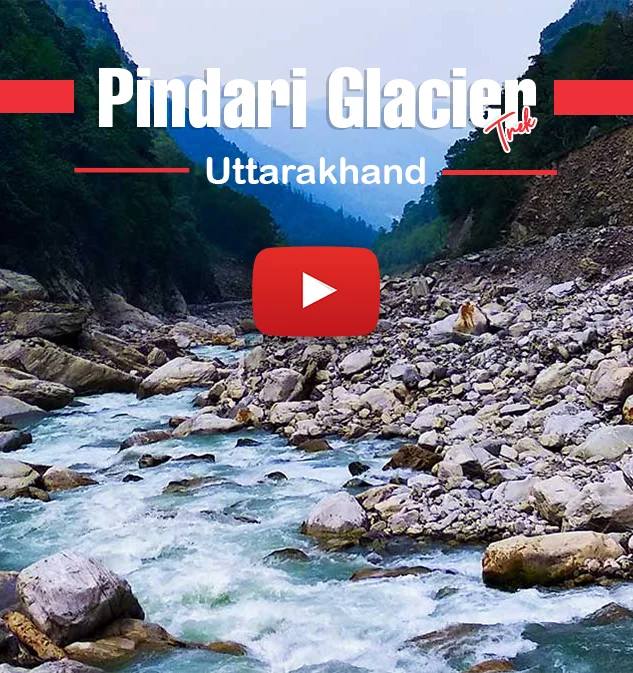
Who Can Participate
-
Age; 12 years +.
-
First timers can apply; previous trekking experience is more appreciated.
-
The climber must be fit and have sufficient stamina to cover 5 km of distance in 30 minutes without stress.
-
The climber should be able to carry a 10-15 kg backpack.
-
Pulse rate at rest must be in between (60 to 90 beats per minute)
-
Blood Pressure Reading must be in between (DIASTOLIC 70 – 90, SYSTOLIC 100 - 140 mm Hg)
-
Respiratory rate at rest must be in between (12 to 20 breaths per minute)
-
Should not have Liver and kidney issues
-
Should not have Diabetes Mellitus, Bronchial Asthma, Heart problems, Hypertension etc
-
No pacemaker implant
-
People with the Sinus issues, Epilepsy please contact to trek coordinator before booking the trek
-
If your BMI is not normal, Please contact our Trek coordinator before Trek booking.
Medical & Disclaimer Form (Mandatory Documents) Click here to download Medical & Disclaimer Form
- Government Employees can avail the benefit of Special Casual Leave (SCL) when you join us for a trekking expedition. As per the rules of the Pay Commission, Special Casual Leave can be availed for up to 30 days in a calendar year for trekking/mountaineering expeditions through a registered organization. Trek The Himalayas is a registered adventure tour operator by Indian Mountaineering Foundation (IMF) and Ministry Of Tourism (MOT)
- Trekkers have to apply for leave at least 20 days before trek departure date,
- This service is exclusive to Indian government employees and is applicable only for treks within India.
- Do mail at info@trekthehimalayas to apply and mention your booked trek date and trek name.
- Junior trekkers (below 15 years) should have a company of parents/guardians.
- Trekkers between 15 to 18 years can come solo with the disclaimer form signed by parent/guardian.
- Medical & Disclaimer Form (Mandatory Documents) Click here to download Medical & Disclaimer Form
Itinerary
Drive From Kathgodam To Khati Village | Enjoy The Scenic Beauty Of Kumaon
This is the first day of your journey towards Pindari Glacier and we will meet you at the Kathgodam Railway Station. A pickup will be scheduled early in the morning around 6:00 AM, where our representatives will pick you up and drive you to Khati, your base camp for the Pindari Glacier trek. Khati is an ancient village with exciting mythological stories attached to it.
From Kathgodam to Khati it’s a scenic drive through the beautiful Kumaon region. You will pass through many scenic destinations like Bheemtal, Almora, Bageshwar, and Kapkot to arrive at the quaint hamlet of Khati. Almora and Bageshwar are two beautiful towns of Kumaon and all along the route, you will see a lot of greenery all around. Khati is the last village on the road that connects the trail to the Pindari Glacier trek route. After reaching Loharkhet, you will follow an off-trail motorable road to Khati. If you wish to withdraw cash, Kapkot is the last ATM point, there are no cash facilities in Khati.
Khati is a fairly large village and a base for backpackers. You can get clear views of Nanda Kot, Nandabaner, and Laspadhura. The locals in Khati village are very friendly and hospitable and you can chat with them and get a glimpse into the rural lifestyle. According to the folklore, it is believed that this village served as a home for the Pandavas when they were in exile. Only the BSNL network is available in some parts of the village. There is also no electricity in the village and the locals rely on solar power for electricity generation. Once we reach Khati we will stay the night at the Khati campsite. Make yourself comfortable and after dinner rest in your tents.
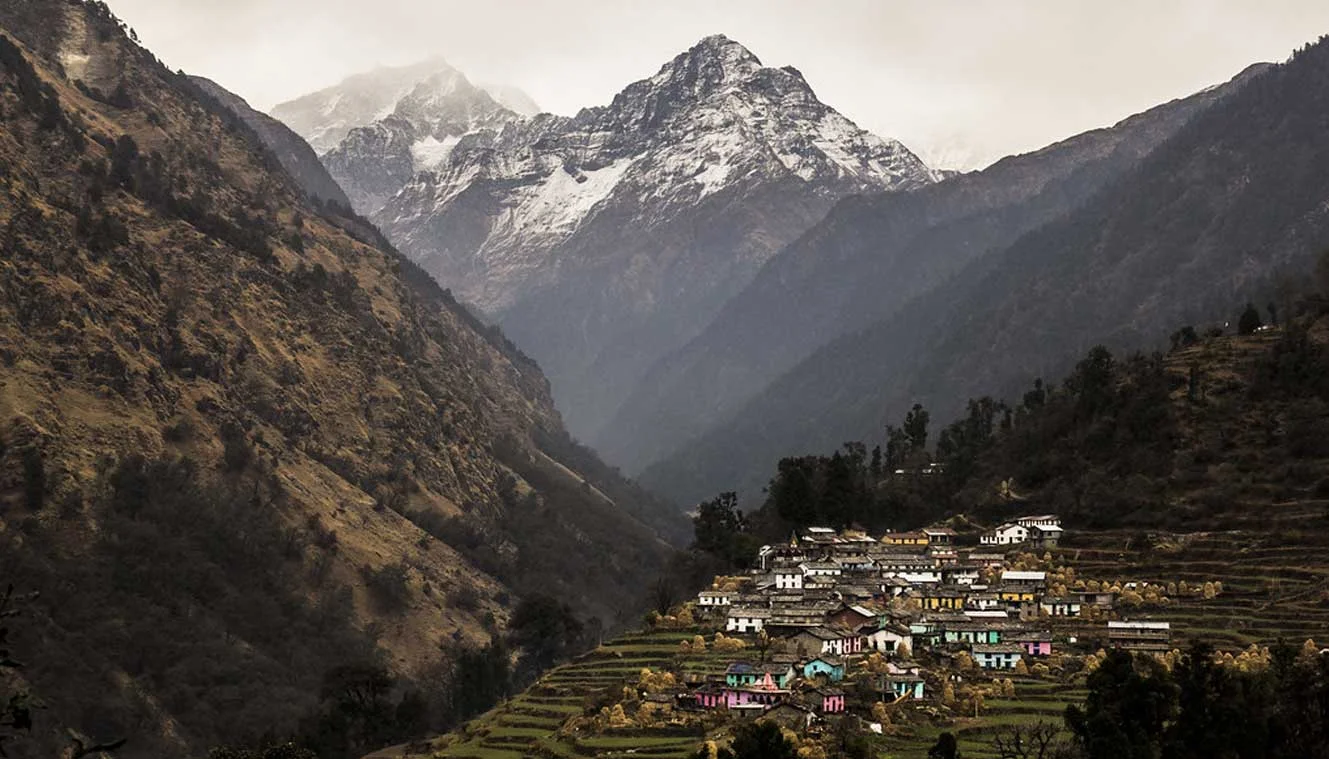
Trek From Khati To Dwali | Walk By The Beautiful Pindar River
Today is a long trek and we have quite a bit of walking to do so we will start our day with a hearty breakfast. From Khati to Dwali, you will cover a distance of 13 km which takes around 6 to 7 hrs depending on the speed of the trekker.
A significant part of today’s trek will be filled with the sound of gurgling water as the Pindar Ganga River accompanies you on the trek. You will cross some log bridges and beautiful waterfalls as you stride towards Dwali. You will come across many caved-in zones and landslide-prone areas in today’s trek. Many parts of the trail have been broken by the 2013 calamity and thus the trail is quite fractured, the trekkers need to be cautious and follow the instructions of the trek leader for safe passage. Weather in the Pindar Valley is quite unpredictable and is prone to rain and as such we will start early.
The initial part of the trek for about 20 minutes is a little strenuous with a steep ascent. Completing the ascent, you will get a bird’s eye view of the Khati village behind you. After another 15 minutes, the uphill gradient gradually reduces and soon you will pass by a stream. This is your first water point in today’s trek. You can fill your water bottle here if you please. The trail turns left from here passing by the KMVN guest lodges and it gradually ascends until you reach a wooden bridge, this bridge helps you cross the first landslide zone. After crossing the bridge the trail becomes quite narrow and descends rapidly and you are inside a forest cover once again. You will spot the beautiful Pindar River rushing down on your left and you will come across another steep descent. Walk downhill for 15 more minutes and the trail levels out a bit, after walking for another 5 minutes, you will arrive at the second landslide zone.
The trail in front of you is broken due to the disaster of 2013 and hence we will take a detour towards the left and climb down towards the Pindar River. Be a little cautious as the descent can be a little slippery. Once at the River, cautiously cross the bouldered landslide zone. Follow your trek leader's advice to cross the area safely. Crossing the section, you will spot a temporary trail moving up towards the same ridge that you came down from and this again connects you to the trail to Dwali. The climb up is steep and slippery and so you need to be careful. On reaching the ridge, walk straight ahead until you are in a forest ridge. Walk for about 10 minutes and you will come across another landslide zone. You have to leave the Dwali trail once again and recede down to the riverbank walking along the riverbank through moraines and mountain bends you will reconnect with the Dwali trail once again.
Walk for 15 minutes and you are again at a landslide zone, this is the fourth landslide zone on the trail. Descend to the river once again all the way to the shepherd huts and a marked trail takes you up to the ridge once again. Walk through a short stretch of forest cover and soon you will spot the fifth landslide zone down below. Get ready for another detour and probably the longest one. Descend down to the riverbed and prepare yourself to cross a difficult moraine stretch. This is a difficult part and you have to cross huge boulders and a total of 4 scissor bends before you reach the ridge once again. Locating the trail to the ridge is quite difficult as it is hidden in dense vegetation. Do not worry our experienced guides and trek leaders are here to help you see the way through. The climb to the ridge can be a little strenuous.
Once you are back on the Dwali trail, keep walking ahead for about 15 minutes and you will arrive at an uphill section, the uphill stretch is about 2 km long and you will arrive at the sixth and final landslide zone. You will have to climb down the riverbed once again, the descent here is pretty unstable as the terrain is basically loose gravel and builders. Be cautious and take precautions to avoid any accidents. Once you are down at the riverbank, you have to walk through moraines until you are at a river crossing section. Diwali lies across the River and crossing the river, you will arrive at Dwali. The destruction caused by the calamity of 2013 is quite evident here. It washed away many sections of the old trail.
We will arrive in Dwali by the evening, where you can settle down at the campsite for a beautiful panoramic view. There’s a PWD guest house near the camping spot and drinking water is also available You'll have dinner at the campsite and an overnight stay in the camps.
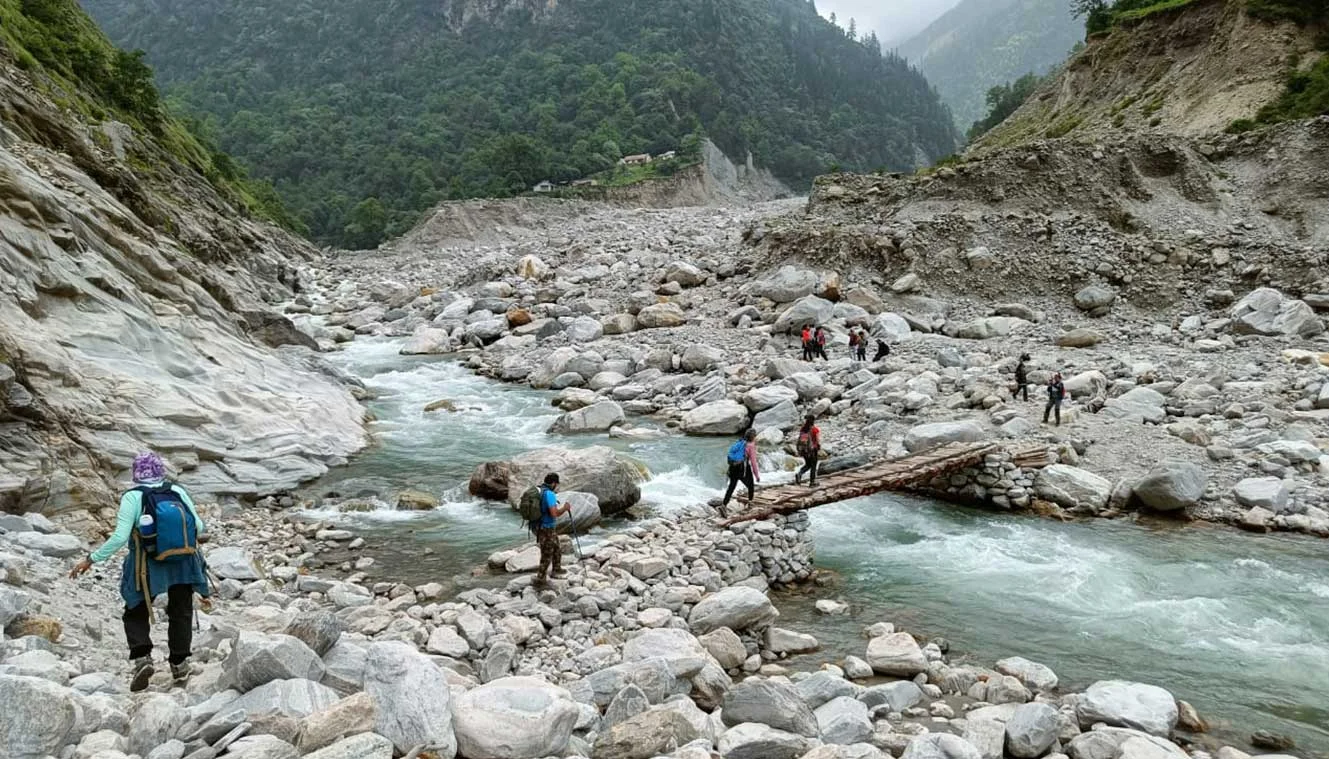
Trek From Dwali To Phurkia | Cross Spiderwalls And Frozen Streams
Today’s trek is fairly easy as compared to the previous days strenuous trek. After having a hot cup of tea and an earth breakfast, we will head out towards Phukria. It’s a short trek of 5 km for about 3 hrs and you will spot some beautiful Rhododendron forest on the way today. On a clear day, Mt. Nanda Devi and Nanda Khat are clearly visible in front of you. En route, you may spot Himalayan Ibex grazing in the pasturelands. Today you will come across another two stream crossings, which are nothing but layers of hard snow. Crossing through the stream, you will arrive at the Phurkia campsite. We will pitch our tents at the campsite and late in the evening, you will be served a hot and delicious meal.
Today is one of the most picturesque stretches on your trek and you will be greeted with stunning views of snow-capped mountains. The trail today leads you deep into the Pindar Valley and it soon starts to ascend upwards as you enter into beautiful Oak and Rhododendron cover. The trek has quite a few forested switchbacks as you gradually gain altitude. As you climb uphill, you will see the Pindar River flowing below in a narrow gorge. If the weather is clear, you will be able to see Mt. Nanda Khat (6545 m) and the Nanda Devi East (7,434 m) looming in the skyline ahead. Further ahead, you will see a green meadow which looks quite appealing and after about 30 minutes of walking, you will arrive here. This meadow is a great vantage point to click some nice photographs for the gram.
You will spot some glacial formations on the stream as it flows down to meet the river below. Across the river, you will get to see some Himalayan Ibexes grazing in the pasturelands near a lovely waterfall. You will now trek along this verdant grassland and cross another glacial stream to enter into another meadow, more scenic than the previous one. From the meadow, you will spot another crimson cover of Rhododendron on the top. It will take about 20 minutes to reach the forest. Entering the forest, you will have to cross a few landslide-prone patches and tricky sidewalls. Our trek leaders will assist you in crossing these difficult sections. It will take about 30-45 minutes to cross these fragmented sections safely.
There are two final stream crossings here and these streams are nothing but hard snow and scree. An ice axe is required here to make footholds and microspikes and crampons are quite useful as well. Remain on the left-hand side of the River and soon you will arrive at the Phurkia Campsite. Look for KMVN and PWD huts for landmarks to the Phurkia campsite. At the campsite a stunning view of the Nanda Khat peak welcomes you. Pitch your tent on the slopes and after a delicious dinner at night, you can rest in your tent.
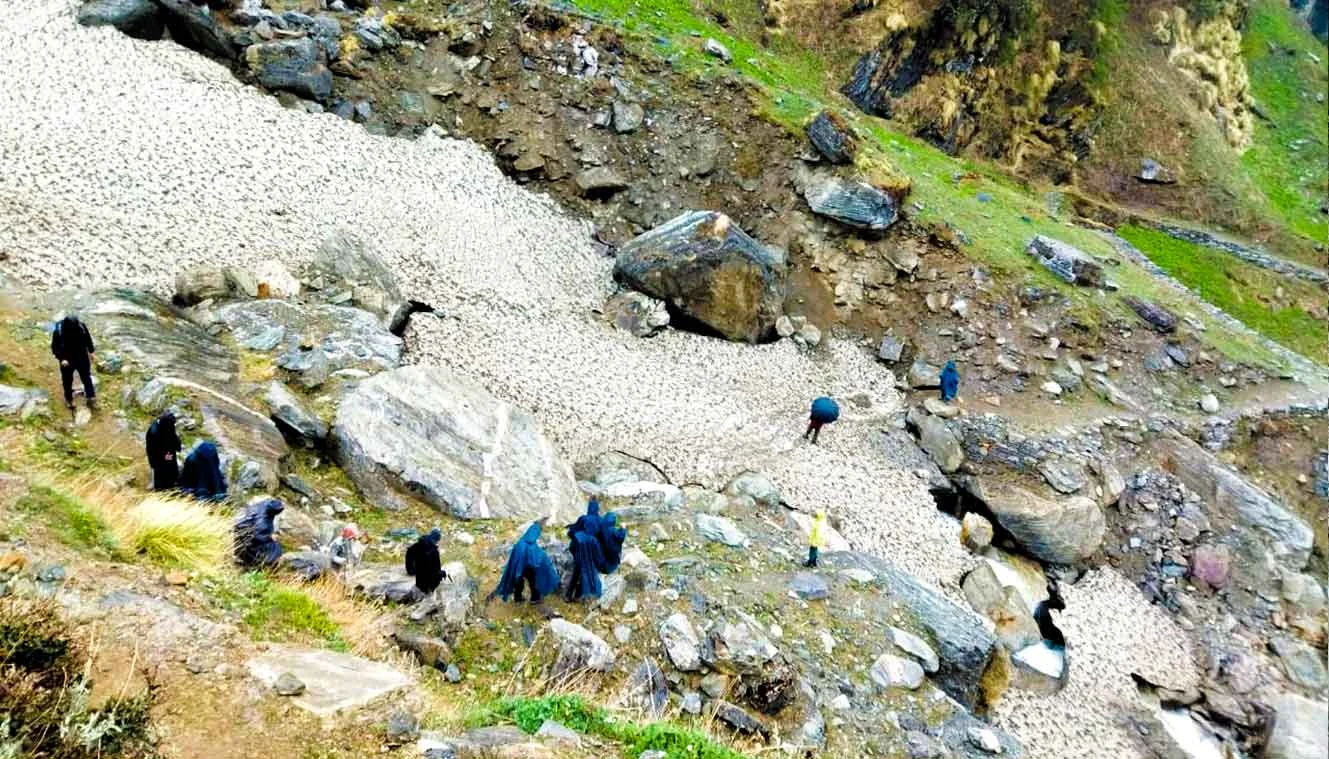
Trek From Phurkia To Zero Point And Back To Phurkia | Summit Day
Today is the most exciting day of your trek and the day you have been waiting for, it’s the summit day. Today we will head to the zero point of the summit and also descend back to Phurkia. From Phurkia, we will take the route on the left of the KMVN hut. It is an uphill hike and after trekking for about 15 minutes, you will arrive at the first stream crossing. The stream is basically a chunk of hardened snow and walks across it to enter the first meadow on your journey today. Trek straight along as the beautiful Mt. Nandakhat dominates the skyline. It is clearly visible from here and on your left, you will see the Pindar River flowing into a gorge below. After walking for about 20 minutes, you will arrive at a rockfall section. This is a pretty sensitive area, so you need to be watchful if there’s any rock falling from above. A little deep into the valley and you will notice patches of hard snow on the trail. Crampons are helpful here as the snow can be quite slippery and crampons will give you the much-needed traction. Soon we will arrive at Bhujani and then continue on towards the Zero Point. Be ready for the thrill of walking on the Pindari Glacier and enjoy a terrific summit view. We have a long trekking day in front of us, so we will start our day as early as possible to reach the summit and return back again. At 3700 m, breathtaking views of the flawless Himalayan landscape are going to leave you spellbound. Weather in Pindar Glacier can change in a matter of minutes so it is best to start early so that you reach the summit early and enjoy some great summit views.
The trail soon gets pretty difficult and before you climb on the Pindar ridge the trail is broken in several places with little foot spacing and a couple of spider wall sections. From here you can clearly see the snow-capped peak of Mt. Bauljuri (5,922 m). Crossing such tricky sections, the trail now turns right and the greenery begins to recede giving way to the snowy ridge of the Pindar Valley. The snow begins to melt from June and the trail is a little easy at that time. It will take about 40 minutes to reach the top of the ridge following a gradual ascent. You will cross a couple of rivulets on the way and these are great water sources as well. Once on the top of the ridge, look on your left and you will catch the first glimpse of the Pindari Glacier on the left. On your right, you can see the snow-ensconced Changuch peak (6,322 m).
You will cross through three ice fields and the snow can be pretty overwhelming in the months of April and May and this can slow you down on the trek. On the left-hand side, you will see a hut and a temple, this is the home of the well-known Pindari Baba, Dharmanand Ji. From here, it will take 40 minutes more to reach the Pindari Glacier Zero Point. Follow the trail straight from Pindari Baba’s hut and keep walking until you reach a moraine ridge. Cross the ridge, and climb till you reach the high point. A board at the summit reads “You’ve reached the Zero-Point”. Treat your eyes to the spellbinding views of mountain peaks like Changuch Peak and Nanda Kot (6,861 m). Spend some time at the summit, basking in the natural beauty and the feeling of accomplishment. We will then return to Phurkia in the same way that we came in. The return can be done pretty swiftly and stay the night in camps.
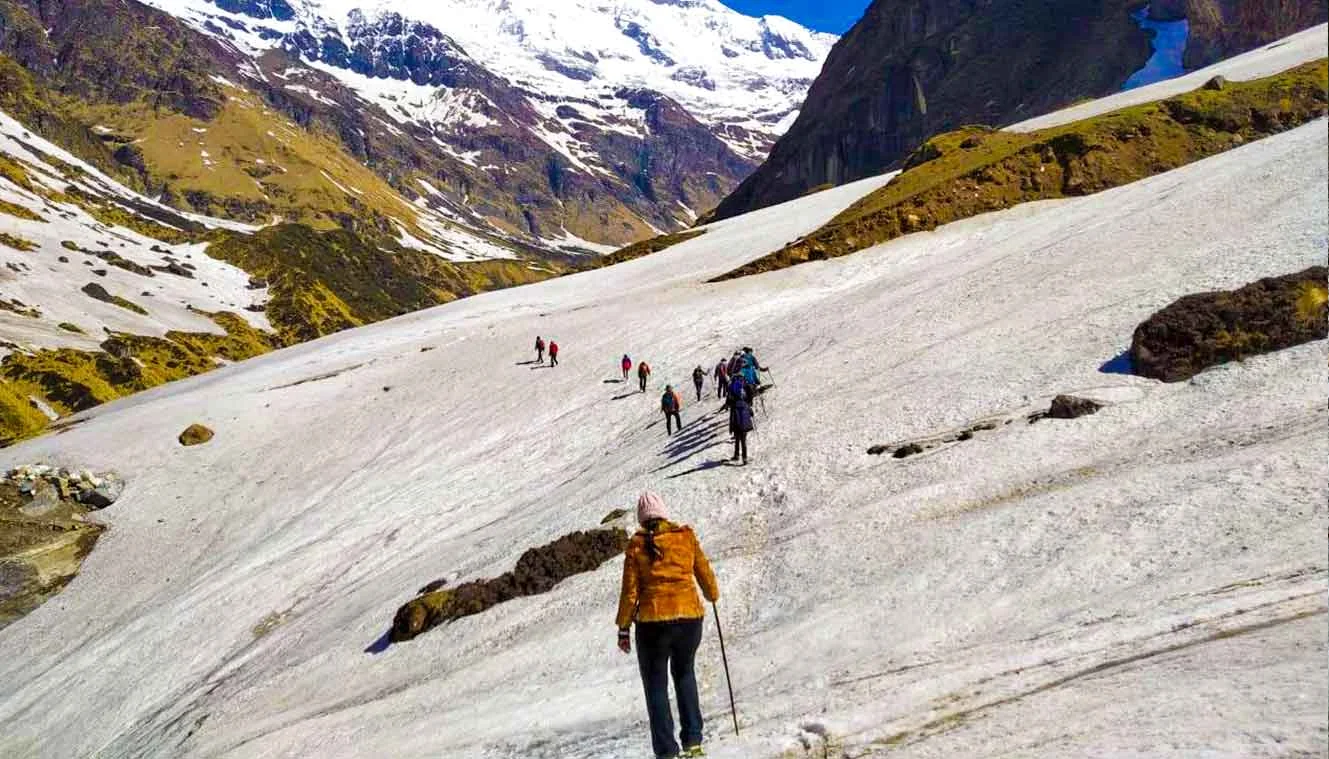
Trek From Phurkia To Khati Via Dwali | Begin Descending
This is your longest trekking day as you will have to trek for 18 km from Phurkia to Khati. It will take 7-8 hr to descend to Khati. From Phurkia, it takes about 2 hrs or less to descend to Dwali and it takes 4 to 5 hrs more to reach Khati. We will descend through the same route that we went up in and cross the same landslide zones on the way while walking along the banks of the Pindar River, we will reach the Khati campsite. We will stay overnight in the camps. Rest well after a long day of trekking
.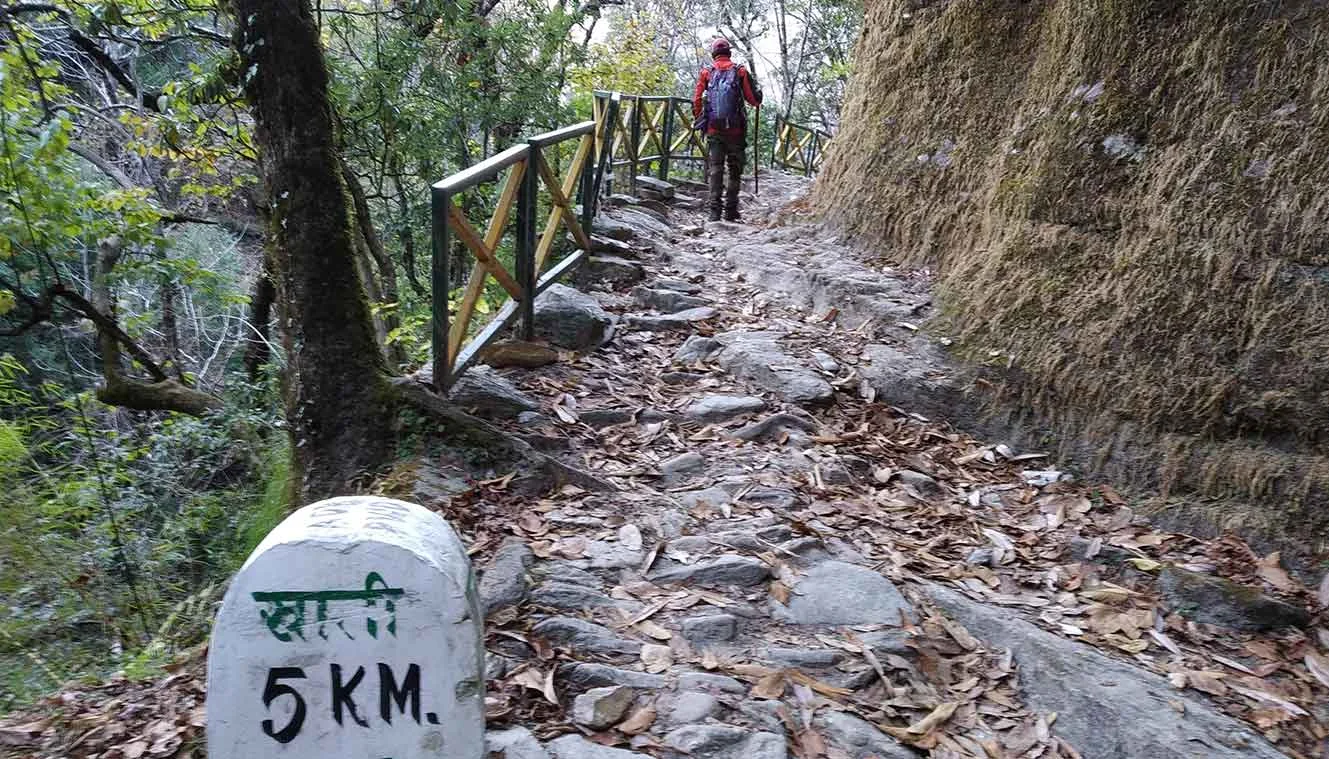
Drive From Khati To Kathgodam | Say Goodbye To The Mountains
Today is the last day of your journey and you will return back to Kathgodam bidding adieu to the mountains and leaving with a bagful of memories. Starting early in the morning, you will trek down from Khati to Kharkia. Its a 4 km trek and takes about 1 hr to descend. From Kharkia road-head, we will drive you back to Kathgodam and you will reach Kathgodam by evening, so make your further bookings accordingly. Drop-off is provided by TTH and is included in the cost.
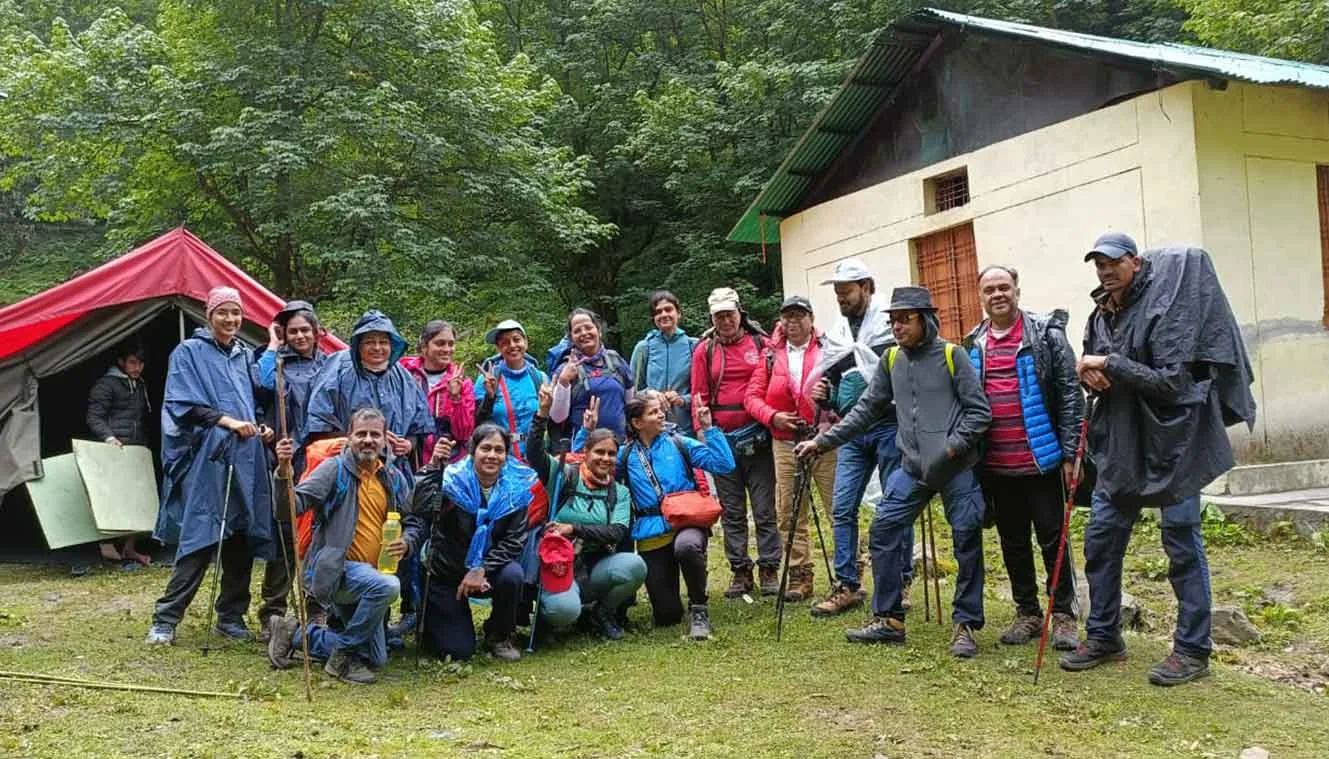
Day-1: Drive From Kathgodam To Khati Village | Enjoy The Scenic Beauty Of Kumaon
- Altitude: 2200 m/ 7300 ft.
- Distance: 214 km approx. | Duration: 9 to 10 hrs.
- Pick up: 6 am | Pick up spot: Kathgodam Railway Station.
- Route: Kathgodam - Bheemtal - Almora - Bageshwar - Kapkot - Loharkhet - Kharkiya - Khati.
- BSNL network is available.
- Last ATM point: Kapkot.
- Stay in tents (twin sharing).
Day-2: Trek From Khati To Dwali | Walk By The Beautiful Pindar River
- Altitude: 2,600 m/ 8,600 ft.
- Trek Distance: 13 km Duration: 7-8 hr.
- Altitude Gain: 400 m/ 1,300 ft.
- Water Source: Multiple water sources on the trek.
- Cross 6 landslide zones.
- Stay in camps (twin-sharing).
Day-3: Trek From Dwali To Phurkia | Cross Spiderwalls And Frozen Streams
- Altitude: 3,200 m/ 10,500 ft | Distance: 5 km | Duration: 3 hr.
- Altitude Gain: 600 m/ 1,900 ft.
- Flora: Rhododendron, Oak.
- Fauna: Himalayan Ibex.
- Cross two frozen streams.
- Peak Views: Nanda Khat (6545 m), Nanda Devi East (7, 434 m).
- Stay in tents (twin-sharing).
Day-4: Trek From Phurkia To Zero Point And Back To Phurkia | Summit Day
- Altitude: 3,700 m/ 12,100 ft.
- Distance: 16 km | Duration: 6 to 7 hrs.
- Trek through the inner realms of Pindar Valley.
- Peak views: Nanda Khat (6545 m), Nanda Kot (6,861 m), Mt. Bauljuri (5,922 m), and Changuch Peak (6,322 m).
- Stay in tents (twin-sharing).
Day-5: Trek From Phurkia To Khati Via Dwali | Begin Descending
- Altitude: 2,200 m/ 7,300 ft.
- Trek Distance: 18 km | Duration: 7 to 8 hr.
- Altitude Loss: 1,000 m/ 3,200 ft.
- Stay in tents (twin-sharing).
Day-6: Drive From Khati To Kathgodam | Say Goodbye To The Mountains
- Altitude: 2,050 m/ 6,750 ft.
- Trek Distance: 4 km | Duration: 1 hr.
- Drive Distance: 210 km | Duration: 9 to 10 hrs.
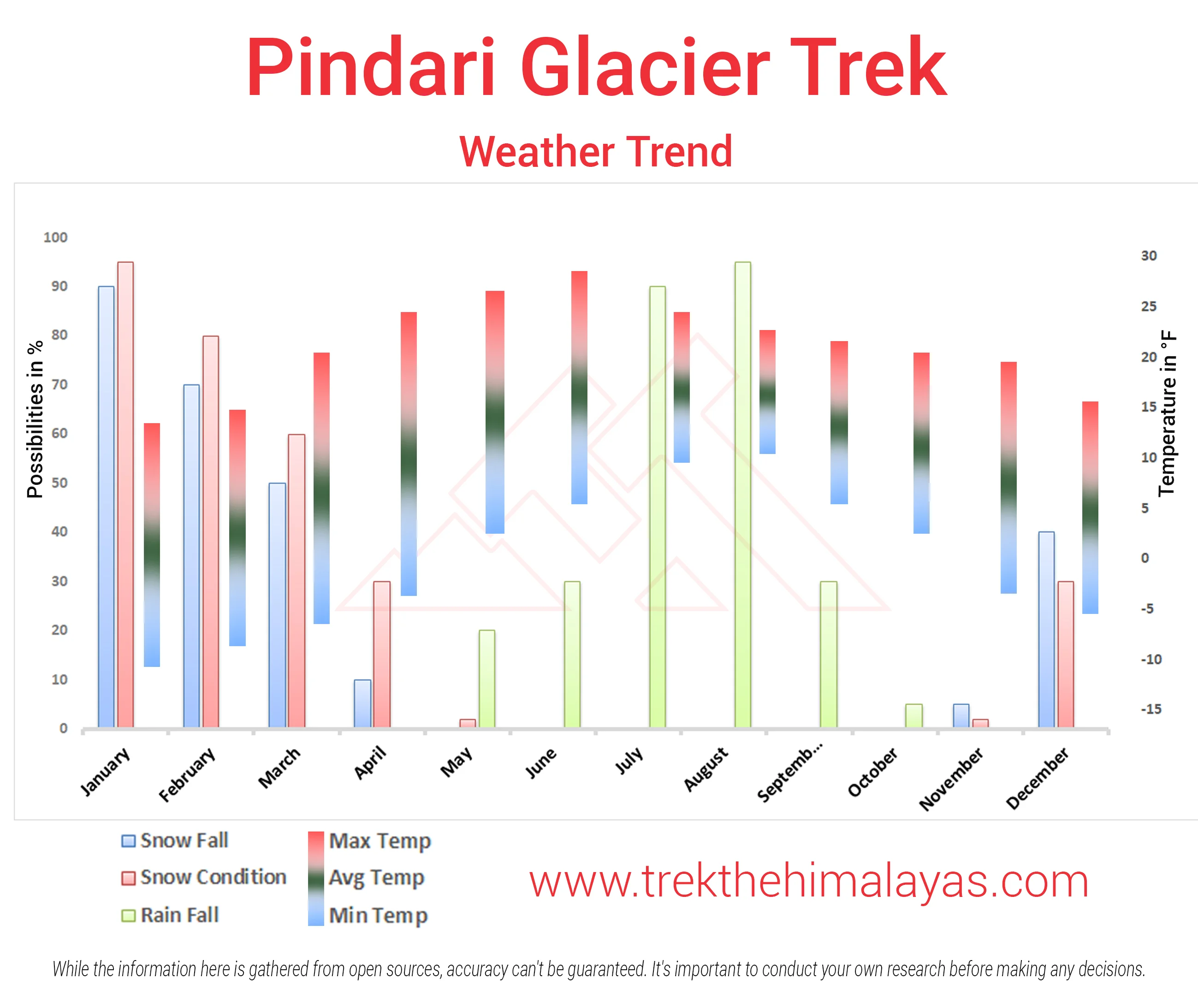
Important Links
- Mandatory Documents to Bring on A Trek Click Here.
How To Reach
.
The designated drop-off point is Kathgodam railway station by 6:00pm.
Please consider planning your subsequent travel arrangements after 7:00 pm.
The distance from Kathgodam railway station to Haldwani is 6km, it will take approx 20 minutes.
TTH offers comfortable transportation through Tempo Traveler, Bolero, or equivalent vehicles. If you wish to upgrade your mode of transportation, please contact your trek coordinator for further assistance.
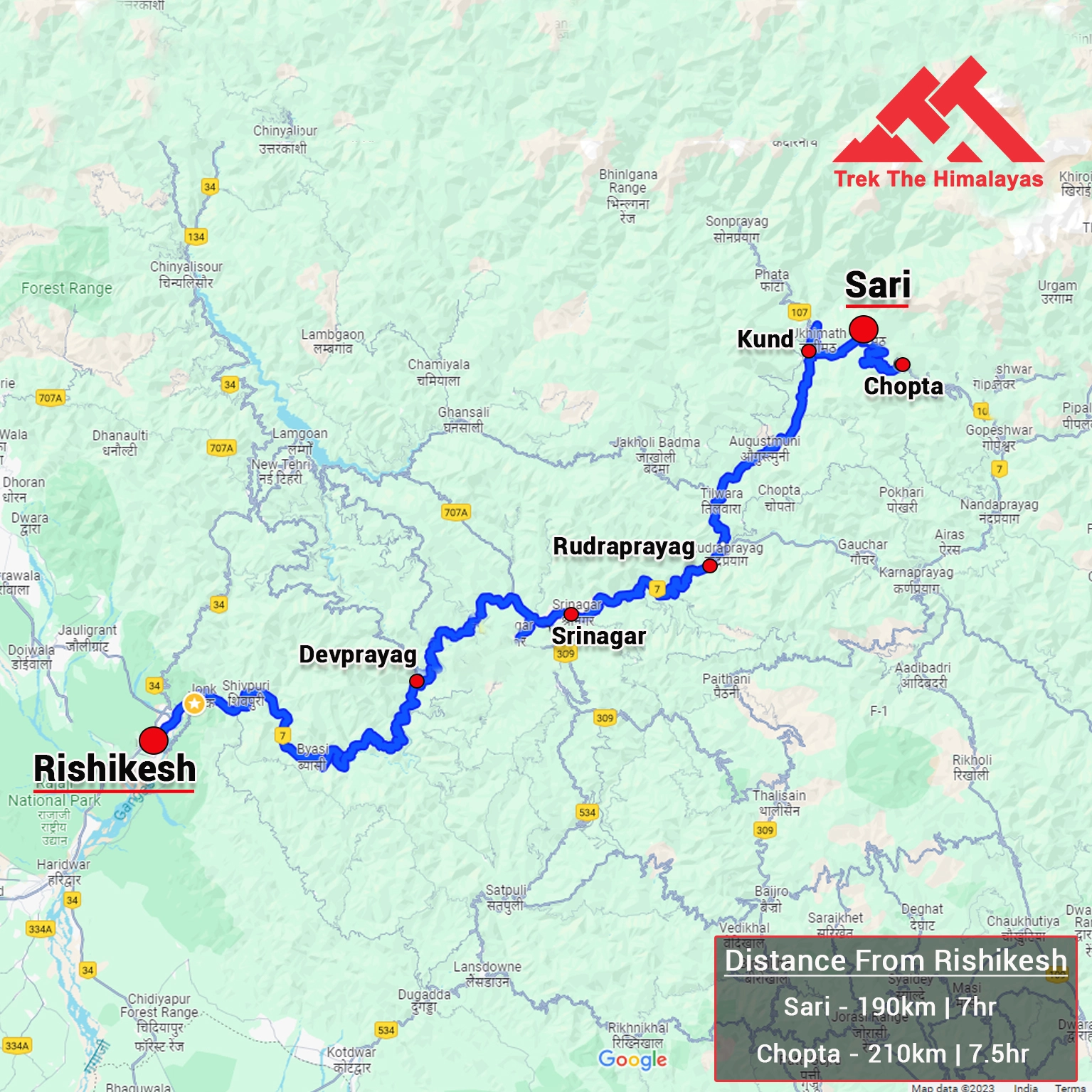
Cost Terms
Inclusion
1. Accommodation (as per the itinerary):
- Guest house, Home Stay.
- Camping while the trek (Twin sharing basis).
2. Meals (Veg + Egg):
- Meals while on trek(Veg + Egg).
3. Support:
- 1 Versatile base camp manager: handles communication and deploys extra manpower in emergencies.
- 1 Mountaineering & First aid qualified professional trek Leader.
- 1 Experienced high altitude chef.
- Local experienced guides (Number of guides depending on the group size).
- Enough support staff.
4. Trek equipment:
- Sleeping bag, Sleeping liners (if required), Mattress, Utensils.
- 3 men all season trekker tent (twin sharing), Kitchen & Dining tent, Toilet tent.
- Camping stool, Walkie talkie.
- Ropes, Helmet, Ice axe, Harness, Gaiters & Crampon (if required).
5. First aid:
- Medical kit, Stretcher, Oxygen cylinder, Blood pressure monitor, Oximeter, Stethoscope.
6. Transportation (as per the itinerary):
- Transport from Kathgodam to Kathgodam.
7. Mules/porters to carry the central luggage.
8. Clock room facility available at the base camp for additional luggage.
9. All necessary permits and entry fees, Upto the amount charged for Indian.
Exclusion
1. Insurance (Mandatory).
2. Food during the transit.
3. Any kind of personal expenses.
4. Mule or porter to carry personal luggage.
5. Emergency evacuation, hospitalization charge or etc.
6. Anything not specifically mentioned under the head Inclusion.
Things can be provided on demand and availability (participant has to pay extra for these things).
1- Satellite phone/set phone - is a type of mobile phone that connects via radio links via satellites orbiting the Earth instead of terrestrial cell sites like cellphones. Therefore, they can operate in most geographic locations on the Earth's surface.
2- Gamow/PAC HAPO Bag (Portable Hyperbaric Bag) - is a unique, portable hyperbaric chamber for the treatment of acute mountain sickness (AMS), also known as altitude sickness.
3- AEDs (Automated External Defibrillators) - are portable life-saving devices designed to treat people experiencing sudden cardiac arrest, a medical condition in which the heart stops beating suddenly and unexpectedly.
Cancellation terms:
Cancellations prior to 25 days from the start of the Trip
Refund options
- 5% deduction of trek fee
- 100% cash voucher for any trip till one year
- Transfer your trek (any trek, any date) to your friend
Cancellation between 24 days and 15 days to the start of the Trip
Refund options
- 30% deduction of trek fee
- 100% cash voucher for same trip till one year
- 85% cash voucher for any trip till one year
- Transfer your trek (same trek, any date) to your friend
Cancellation between 14 days and 10 days to the start of the Trip
Refund options
- 50% deduction of trek fee
- 80% cash voucher for same trip till one year
- 70% cash voucher for any trip till one year
- Book the same trek, in the same season, with any other batch
- Transfer your trek (same trek, any date) to your friend
Cancellation less than 9 days to the start of the trek
Refund options
- No cash refund
- 20% cash voucher for the same trip till one year
- 10% cash voucher for any trip till one year
- Transfer your trek (same trek, same date) to your friend
Note- If a booking is made using a voucher or discount code, the policies related to vouchers and discounts cannot be modified.
In the unlikely event that TTH cancels a trek prior to the scheduled departure date:
While it is extremely rare for TTH to cancel a trek, we understand that unforeseen circumstances or natural disasters may occasionally require us to do so before the scheduled departure. These circumstances could include continuous rain or snow, thunderstorms, snowstorms, landslides, floods, earthquakes, or any other natural calamity that poses a risk to the safety of our trekkers. Additionally, unforeseeable events such as local riots, curfews, pandemics, lockdowns, government orders, or any similar situations that compromise the safety of the trekking experience may also necessitate a cancellation.
In the event of such a cancellation, TTH will provide you with a voucher equivalent to the amount you paid for the trek. This voucher can be redeemed for any of our treks within the next year, allowing you to still enjoy an adventure with us at a later date.
Note
-
The issuance of a voucher is not applicable in situations where you are required to descend from the trek for any reason. The trek leader may make the decision to send you down from the trek due to factors such as insufficient fitness level, symptoms of Acute Mountain Sickness (AMS), high blood pressure, exceeding the designated turn-around-time, health concerns, or if you are found smoking, drinking, or violating the rules set for the trek. In such cases, the provision of a voucher does not apply.
In the rare event that TTH shifts a trek:
We would like to emphasize that weather conditions in high-altitude areas are highly unpredictable and can undergo sudden changes at any time, irrespective of the day. Additionally, circumstances beyond our control, such as natural disasters, political unrest, pandemics, and lockdowns, may impact the feasibility of conducting a trek. In cases where we are unable to proceed with an event due to such circumstances that are beyond our direct control, we will make every effort to provide you with an alternative trek that is safer and more suitable.
In such situations, we will issue a voucher to offset the cost difference between the originally scheduled trek and the alternative trek. This voucher can be redeemed at any time within one year from the date of issue. Please note that a refund fee or reimbursement of the cost difference is not applicable in these cases.
Note:
- Change of trek batch is dependent on the availability of seats in the batch
- In case of transferring a trek to a friend, he/she should satisfy all the mandatory requirements put forward by TTH
- TTH holds the right to change/cancel the policies, without prior notice
- Cash refund is applicable only in case of bookings made without using any promotional offer code or vouchers
Cash Voucher Terms:
- This is a non-transferable voucher
- The voucher cannot be merged with any other offer of Trek The Himalayas
- The voucher is valid for Trek booked directly with Trek The Himalayas in India
- To avail the voucher please use your register phone number or e-mail id
- All the other Terms of booking a trek with Trek The Himalayas are applicable to the voucher
- Trek The Himalayas holds rights to add/remove any of the Terms and Conditions without prior notice
Itineraries are based on information available at the time of planning and are subject to change. "Trek The Himalayas" reserves the right to change expedition dates, people or itineraries as conditions warrant. If a trip must be delayed or the itinerary changed due to bad weather, road conditions, transportation delays, government intervention, airline schedules, sickness, or other contingency for which TTH or its agents cannot make provision, the cost of delays and/or other changes are the responsibility of the participant. TTH reserves the right to decline, or accept, any individual as a trip member for any reason whatsoever.
Trek Essentials
PDF Of Trek Essential Download
| Backpack with rain cover | (50 - 60 ltr) with comfortable shoulder straps |
| Day pack with rain cover | 20 - 30 ltr (If off-load opted) |
| Walking stick | Advisable (At least one) |
| Water Bottle / Hydration pack | 2 bottles of one liter each, People who use hydration pack 1 hydration pack and 1 bottle of one liter, Carry at least one thermos flask. |
| Small size tiffin/lunch box | 1 Nos |
| Snacks | Energy bars, dry fruits, electoral/ors |
| Personal Medical Kit | Consult your doctor |
| T-Shirt (Synthetic quick dry) | 1 Full & 2 Half sleeves |
| Fleece T-shirt | 1 Nos |
| Wind stopper / Fleece jacket | 1 Nos |
| Windproof Jacket | 1 Nos |
| Down feather / Hollow jacket | 1 Nos |
| Thermal inner (Upper and Lower) | 1 Pair |
| Trek Pant (Synthetic quick dry) | 2 Nos |
| Wind stopper / Fleece Pant | 1 Nos |
| Waterproof gloves | 1 Pair |
| Fleece / woollen gloves | 1 Pair |
| Poncho / waterproof Jacket and pant | 1 Nos |
| Sunscreen | 1 Nos |
| Moisturiser | 1 Nos |
| Chap-stick / Lip balm | 1 Nos |
| Toothbrush and toothpaste | 1 Nos |
| Toilet paper & Wipes | 1 Nos |
| Soap / hand sanitizers | 1 Nos |
| Antibacterial powder | 1 Nos |
| Quick dry towel | 1 Nos |
| Head torch | 1 Nos. (Avoid Hand torch) |
| Sun Cap | 1 Nos |
| Woolen cap | 1 Nos. |
| Balaclava | 1 Nos. |
| Buff / Neck-gaiters | 1 Synthetic & 1 Woollen |
| Sunglasses | UV with dark side cover, People who wear spectacles - (A)- Use contact lenses | (B)- Photo chromatic glasses |
| Trekking shoes | 1 Pair (Waterproof, high ankle, good grip) |
| Floaters / flip-flops | 1 Pair |
| Cotton socks | 6 pairs |
| Woollen socks | 1 pairs |
| Gaiters | 1 Pair (TTH provides when required) |
| Micro spikes | 1 Pair (TTH provides when required) |

Frequently Asked Questions(FAQ)
To register with TTH, visit our website - www.trekthehimalayas.com and create your account. To create your account you will need to use your email address and fill in all the details, set your unique password and your account is ready to use.
- To book a trek with TTH, you first need to register with us and create an account.
- Choose the trek that you want to do and click on available dates.
- You will land at the login page, fill in the required details.
- Add Participants, choose add-on services click on the Pay now button, choose your preferred payment method, and make the payment. TTH accepts multiple payment options, including credit/debit cards, net banking, and UPI.
- You will receive a confirmation email from TTH with all the necessary details about the trek, including the meeting point, transportation, accommodation, and other important instructions.
please send an email to us at info@trekthehimalayas.com or reach out to the numbers provided in the Help and Support section of your Trek Page. We will ensure that your issue is promptly resolved.
To book services such as off-load luggage and transportation, you can find them listed as add-ons. These additional services can be booked at the time of your initial booking. If you miss booking add-ons during the initial reservation, you can log in anytime and easily book 4 days before the departure date add-ons through the platform.
In such a situation, please log in to your account and transfer your trek or date to the desired one within 12 hours or drop us an email at info@trekthehimalayas.com 10 days before the departure date of the trek. After the initial 12-hour period, any changes will be processed according to the cancellation policy.
We recommend visiting our "Suggest Me a Trek" page. By filling out the form, our experts will contact you with the best possible trek options based on your preferences and experience level. Alternatively, you can reach out to us via email at info@trekthehimalayas.com or give us a call using the numbers provided on our website for personalized assistance and recommendations.
Family treks differ from regular treks by focusing on ease of difficulty, offering shorter durations for younger participants, Kid-friendly and easily digestible foods, child-friendly activities, maintaining a higher guide ratio for diverse age groups, and implementing additional safety measures for families.
Family Trek with Kids recommendation Only Dayara Bugyal and Chopta Chandrashila Trek.
Minimum age for TTH treks is typically 7 years, though this may vary depending on the specific trek.
Yes, you can take a kids to a high-altitude trek with a parent. Discuss with a trek expert before booking a trek.
Junior trekkers (below 15 years) should have a company of parents/guardians.
Trekkers between 15 to 18 years can come solo with the disclaimer form signed by parent/guardian.
Medical & Disclaimer Form (Mandatory Documents) Click here to download medical and disclaimer form
Physical Fitness: Ensure your child is physically fit. Engage them in regular exercise, outdoor activities, and hikes to build stamina and endurance. Hydration: Emphasize the importance of staying hydrated at high altitudes. Encourage your child to drink water regularly, even if they don't feel thirsty. Proper Nutrition: Provide a well-balanced diet with sufficient carbohydrates for energy and foods rich in iron to prevent altitude sickness. Adequate Sleep: Ensure your child gets enough sleep in the days leading up to the trek. Quality rest is crucial for altitude adaptation. Educate on Altitude Sickness: Teach your child about the symptoms of altitude sickness, such as headache, nausea, and dizziness. Encourage them to communicate any discomfort immediately. Appropriate Clothing and Gear: Dress your child in layers to adjust to changing temperatures. Ensure they have appropriate trekking gear, including sturdy footwear. Positive Mindset: Foster a positive mindset. Encourage your child, and let them know it's okay to take breaks when needed. Medical Check-Up: Schedule a medical check-up before the trek to ensure your child is fit for high-altitude activities. Consult with a healthcare professional about any potential health concerns.
TTH takes special care to provide wholesome and nutritious food for children on treks. Here are some of the foods that are typically served for children:
Breakfast: For breakfast, TTH serves a variety of options like porridge, cornflakes, bread, butter, jam, honey, boiled eggs, omelettes, and pancakes. Children can choose from these options to fuel themselves for the day's trek.
Lunch: For lunch, TTH serves lunch which includes rotis, vegetables, rice, dal, and salad. The rotis are usually made fresh on the trek and are a good source of carbohydrates. The dal and vegetables provide protein and other essential nutrients.
Snacks: TTH provides healthy snacks like fresh fruits, dry fruits, energy bars, cookies, and biscuits to keep the children energized throughout the day.
Dinner: For dinner, TTH serves a hot and wholesome meal which includes soup, rice, dal, vegetables, and a non-vegetarian dish (if requested in advance). Children can also choose from a variety of desserts like custard, jelly, and fruit salad.
Dietary requirements: If a child has any special dietary requirements, TTH can cater to those needs as well. For example, if a child is lactose intolerant or allergic to nuts, the kitchen staff can make arrangements to accommodate those requirements.
Choosing the right trek for a beginner can be a bit overwhelming as there are many factors to consider such as distance, elevation gain, terrain difficulty, weather, and time of year. Here are some tips that can help you choose the right trek for a beginner:
1. Determine fitness level: Assess the fitness level of the beginner to understand their physical capabilities. This will help you select a trek that is challenging but not too difficult.
2. Choose a well-traveled trail: A well-traveled trail will have more amenities such as signposts, water stations, and shelter. It is also safer as there will be other hikers on the trail.
3. Consider the length of the trek: For beginners, it is recommended to start with a shorter trek that can be completed in a day or two. This will help them get acclimatized to trekking and build their confidence.
4. Look for gradual elevation gain: Choose a trek with a gradual elevation gain rather than steep ascents. This will make the trek easier and more enjoyable.
5. Check the weather: Check the weather forecast before selecting a trek. Avoid treks during the monsoon season or winter when the trails can be slippery or dangerous.
6. Research the trail: Read about the trail to get an idea of the terrain, altitude, and difficulty level. This will help you select a trek that is suitable for the beginner.
7. Consult with an expert: If you are unsure about which trek to choose, consult our trek expert Mr. Nitin (+91 70600 59773) between 10 AM to 6 PM (Tuesday - Friday). Mr. Nitin will provide you valuable advice and guidance.
Overall, it is important to choose a trek that is enjoyable, challenging but not too difficult, and suitable for the beginner's fitness level and experience.
It is not recommended for a beginner to choose a difficult Himalayan trek. Trekking in the Himalayas can be physically and mentally challenging, especially if you are not used to the high altitude, steep slopes, and rugged terrain. Choosing a difficult trek without the proper experience, fitness level, and preparation can be dangerous and put you at risk of altitude sickness, injury, and other hazards.
If you are a beginner, it is recommended to start with an easier trek and gradually build up your skills and experience. This will help you understand the challenges of trekking in the Himalayas, and also prepare you physically and mentally for a more difficult trek in the future. It is also important to choose a trek that matches your fitness level, experience, and interest.
There is no specific age limit for a beginner trekker. However, it is important to consider your physical fitness, health condition, and personal interests before embarking on a trek. Trekking in the Himalayas can be physically and mentally demanding, and requires a certain level of physical fitness and endurance.
If you have any pre-existing medical conditions or are above a certain age, it is recommended to consult with a doctor before embarking on a trek. It is also important to listen to your body and take breaks as needed during the trek to prevent exhaustion or injury.
We recommend visiting our "Suggest Me a Trek" page. By filling out the form, our experts will contact you with the best possible trek options based on your preferences and experience level. Alternatively, you can reach out to us via email at info@trekthehimalayas.com or give us a call using the numbers provided on our website for personalized assistance and recommendations.
Yes, you can join the trek. We have fixed departure groups where you can simply book your trek and we will take care of curating a group.
Before you start the trek, it is recommended that you make all the necessary phone calls as during the trek you may or may not receive network coverage, once you come back to the Base Camp, you can reconnect with your family via phone once again. You can share your trek coordinator contact detail with your family members to get the latest updates about your trek batch.
At TTH, we provide wholesome and nutritious meals during the trek. The food is vegetarian and includes a variety of dishes such as rice, dal, vegetables, chapati, paratha, pasta, noodles, and soup. We also offer snacks such as biscuits, and salty, and dry fruits during the trek. Special dietary requirements such as vegan, gluten-free, or Jain food can also be arranged if informed in advance.
If you are allergic to some foods, you need to let us know in advance so that we can make arrangements accordingly.
TTH is a trekking company that prioritizes the safety of all its participants, including women trekkers. They have a comprehensive safety system in place, which includes a dedicated team of experienced and trained trek leaders and support staff who are equipped to handle emergency situations and provide first aid.
TTH also takes specific measures to ensure the safety and comfort of women trekkers. They have a separate tent accommodation for women trekkers, female trek leaders, and support staff. They also provide separate toilet facilities for women and encourage a safe and respectful environment for all trekkers.
Moreover, TTH has a strict policy against any kind of harassment and has a zero-tolerance policy towards such incidents. They have a designated Internal Complaints Committee (ICC) to investigate and address any complaints related to harassment or misconduct. Overall, TTH has a good reputation for safety and responsible trekking practices, and women can feel comfortable and safe while trekking with them.
In case you are the only women in the group, we provide a single sleeping arrangement. Also, during the trek, the trek leader will always remain by your side to provide optimum safety and reassurance.
You can reach out to the trek coordinator to inquire about the number of female trekkers and their respective states who have booked the trek. Please note that the trek coordinator cannot disclose personal details of any trekker. Once you've confirmed your booking, a WhatsApp Group will be created for all the trekkers in your batch. This allows you to connect with fellow trekkers before the trek begins.
While many of our treks are led by female trek leaders, however, it is not possible to know which trek leader is assigned to which group. But nonetheless, whether the trek leader is male or female you can be completely assured of your safety and security with us.
Yes, it is possible to trek with periods. However, it is important to take some extra precautions and preparations to ensure a comfortable and safe trekking experience.
Here are some tips that can help you trek during your period:
1. Use menstrual hygiene products that you are comfortable with, such as tampons, pads, or menstrual cups. It is recommended to carry enough supplies for the entire duration of the trek.
2. Pack wet wipes, hand sanitizer, and plastic bags to dispose of used hygiene products.
3. Wear comfortable and breathable clothing that allows for easy movement and reduces friction. Avoid wearing tight or restrictive clothing that can cause discomfort.
4. Carry pain relief medication, such as ibuprofen or acetaminophen, in case of menstrual cramps.
5. Stay hydrated and maintain a balanced diet to support your energy levels and overall health.
6. Take breaks as needed and listen to your body. If you feel uncomfortable or experience any unusual symptoms, seek medical attention immediately.
It is also recommended to consult with a doctor before going on a trek during your period, especially if you have a pre-existing medical condition or are taking medication. By taking necessary precautions and being prepared, you can have a safe and comfortable trekking experience even during your period.
We provide proper disposal facilities for sanitary pad disposal during the trek.
We offer three person tents with twin-sharing for optimum comfort. A woman trekker will share a tent with another woman trekker and if you are the only woman in the group, you will be given a single accommodation for your comfort and privacy.
Yes, we do provide gears on rent. You can book it using you TTH account directly.
Mountaineering qualified Experienced and first aid certified Trek Leader, First Aid Certify local guide, Cook, helpers and supporting staff.
People suffering from Bronchitis, Asthma, High blood pressure, Epilepsy (got faints), TB , Heart problem or on higher BMI side are strictly not allowed to go on any Himalayan trek. Apart from this if you had any medical history, please let us know.
No. Alcohol and smocking isn’t allowed while on trek. It is totally misconception that it will keep you warm. Your body need to acclimatize properly and for that eat properly and drink enough water; these things will keep you warm.
Toilet tents provide a convenient solution for answering nature's call in the great outdoors. Dry toilets, in particular, offer a highly sanitary approach. By digging a pit and utilizing mud and a shovel, you can easily cover up your waste. This method ensures cleanliness and hygiene while camping or exploring in the forest.
Remember to pack essential toiletries to complete your outdoor bathroom kit and maintain proper personal hygiene during your adventures. With these practices in place, you can enjoy nature while also respecting it.
Layer Up From Head To Toe
Eat Full Meals, never sleep empty stomach
You can keep warmee (if you’re more susceptible to cold).
Use sleeping bag in right way and don’t leave free space in sleeping bag.
For upper body
– Thermal layer
– T-shirt (full-sleeves)
– Fleece T-shirt (for extreme colds)
– Fleece layer
– Thick Jacket/Down Jacket
– Waterproof or Windproof layer (outermost layer, when it is snowing or raining)
- For Lower Body
– Thermal layer
– Hiking pants (normal) or Winter hiking pants
Based on how warm you feel you can skip any of the above layers. Your outer later should be windproof since it is windy at high altitude.
The idea behind layering is that the more insulation you have the less cold you feel, and instead of wearing a very thick jacket if you wear multiple layers, your body will be better insulated against the cold.
Yes, we provide micro spikes and gaiters, if required.
Mandatory documents: 2 xerox of ID having address (addhar card/driving license), 2 Passport size photographs, hard copy Medical form signed & sealed by doctor, disclaimer form sign by trekker and high altitude insurance.
No. We don’t but we can suggest you good hotel/Stay nearby pick up location.
Yes, trekker must carry 2 water bottles 1 litre each so they can refill it at campsite for drinking and keep themselves hydrate.
You should buy shoes which has these three features –Good grip, Ankle Support and additional water resistant layers. Generally, we advise Quechua Trek 100, MH 500 and MH 100.
Your return transport is also included in trek fee if you're opting for service Dehradun to Dehradun ; we use Tempo Traveller/ Tata Sumo/Max/Boloero kind of vehicle.
No one is forced to go on. There is always enough staff to split the party according to need and regroup later at the camp. Most people have no trouble reaching the highest campsite. If some members decide not to climb the final distance they can wait for the climbers to come back down the same way or take a lateral path to the descent route.
We always have a first aid kit close at hand. Serious injuries are rare. Porters will assist injured climbers to the base of the mountain and onward to a clinic or hospital. Kilimanjaro International Airport is very near Marangu Gate if evacuation to the US or Europe is advisable.
The Pindari Glacier Trek is a popular trekking route located in the Kumaon region of Uttarakhand, India. This trek is famous for its spectacular views of the Pindari Glacier, which is one of the most accessible glaciers in the Indian Himalayas. The trek takes you through some of the most picturesque landscapes of the region, including dense forests, rolling meadows, and gushing streams. The highlight of the trek is reaching the Pindari Glacier, which stands at an altitude of 3,820 meters and offers breathtaking views of the surrounding peaks of the Nanda Devi Range. The trek also offers a unique cultural experience as it passes through several remote villages of the region, where you can interact with the locals and learn about their traditions and way of life. The trek is suitable for both experienced and novice trekkers and is a must-do for anyone who wants to witness the stunning natural beauty of the Indian Himalayas.
Pindari Glacier Trek is a 50 km long trek.
Pindari Glacier Trek is a 6-days long trek.
The maximum altitude of the Pindari Glacier Trek is 12,300 ft.
The best time to do Pindari Glacier Trek is Summer (mid- Apr to Jun) and Autumn (Sep to mid-Nov).
While it is not mandatory to have a professional expert for the Pindari Glacier Trek, it is highly recommended, especially if you are not familiar with the area or have limited trekking experience. A guide can provide valuable assistance in navigating the trail and can help you avoid getting lost or injured. They can also provide valuable insights into the local flora and fauna, as well as the cultural aspects of the region.
Moreover, having a guide can ensure that you are taking the safest and most efficient route, and they can also provide emergency assistance in case of any unforeseen circumstances. Additionally, guides can help arrange for food and accommodation at various points along the trek, making your journey much smoother and hassle-free.
The Pindari Glacier Trek is a moderate-grade trek.
The maximum altitude of the Pindari Glacier Trek is 12,300 ft.
During the Pindari Glacier Trek, you will stay in a guest house in the base camp, and on the slopes, you will be staying in tents (twin-sharing).
Some other popular treks near the Pindari Glacier Trek are Kafni Glacier Trek, Sunderdhunga Treks, and Milam Glacier Trek.
While prior trekking experience is always helpful, it is not necessary to have prior experience to do the Pindari Glacier Trek. The trek is suitable for beginners as well as experienced trekkers.
The Pindari Glacier Trek is a moderate-level trek and can be completed by anyone who is physically fit and able to walk for several hours a day. The trail is well-defined, and there are many rest points along the way. However, it is important to prepare yourself for the trek by doing some basic physical exercises, such as walking or jogging, to build stamina and endurance.
The permits required for Pindari Glacier Trek are Inner Line Permit, Trekking Permit, and National Park Permit. When you trek with TTH, we obtain all the permits for you.
.webp)
.webp)